
How to Measure a Marketing Campaign Effectiveness?
In the world of marketing, data is everything. To make informed decisions and optimize your marketing strategies, it is crucial to measure the effectiveness of your campaigns.
By establishing a structured approach to measuring marketing campaign performance, you can gain valuable insights and quantify the return on investment (ROI) for your marketing efforts.
Digital marketing is on the rise and provides you with endless opportunities for measuring the results in terms of awareness and conversion.
86% of marketers said they've increased brand awareness by using one or more digital marketing channels.
Source: contentmarketinginstitute.com
It turns out that nurturing your leads through inbound marketing can help you generate 50% more sales.
Source: uk.marketo.com
Therefore, it is important to be able to correctly measure the results of your digital campaigns in order to see missed opportunities.
Why Measure Marketing Performance?
Measuring marketing performance is critical to calculating ROI, aligning goals with the management, continual improvement, and making informed decisions. It helps identify areas for optimization, highlights strengths and weaknesses, and provides information for data-driven adjustments.
Marketing campaigns can be arranged in a variety of ways. It's common to focus on a standard approach of measuring only the channels, such as email or social ads. However, this leaves you with disjointed data that won't be helpful in designing the overall marketing strategy.
To define your marketing campaign structure, you should start by setting goals that align with your overall business objectives. Your goals should be specific, measurable, achievable, relevant, and time-bound (SMART).
Secondly, you should divide marketing campaigns by products or projects. Thanks to this, you can find the best tools and gain better visibility on their efficiency.
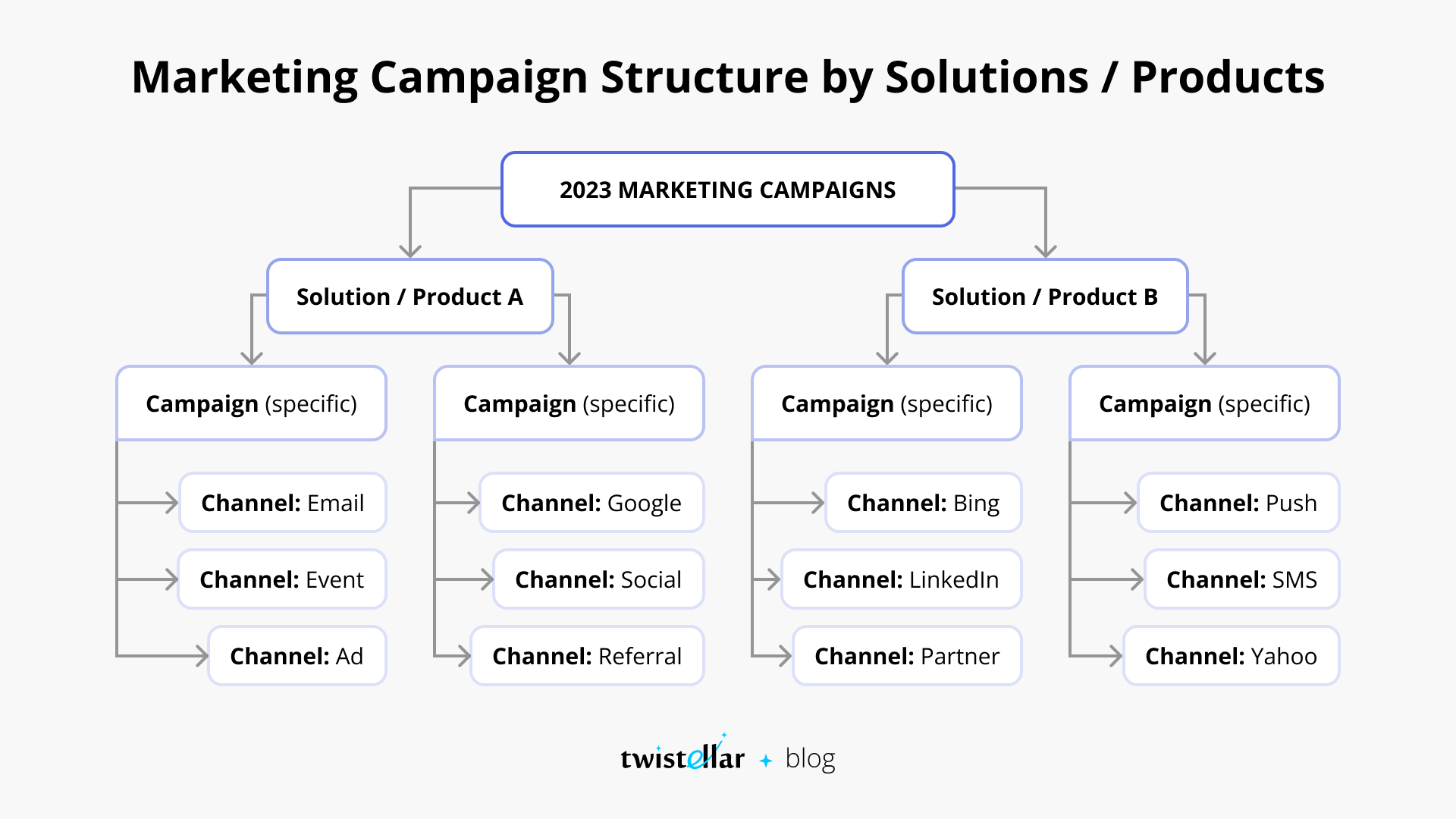
After that, you can define promotion channels, calculate metrics, and set KPIs (Key Performance Indicators). These might include such metrics as website traffic, conversion rates, and customer engagement.
Channels can vary depending on your goals, audience, or product. They include email marketing, paid search, content marketing, events, social media (SMM), public relations (PR), search engine optimization (SEO) and others. At the same time, each channel has its own key metric.
What Metrics Help You Measure a Marketing Campaign Effectiveness?
Marketing metrics help you track the effectiveness of certain actions so that you can continue to adjust your strategy based on this data. Having a big picture of the metrics by stage will help you spot the gaps in your campaigns, show the channels that will bring more results, and finally help you calculate marketing ROI.
By Stage:
1. Awareness: web traffic, traffic by source, keyword rankings.
Web traffic (total visits, page views, session duration, viewing depth) refers to the number of visitors or users who access a website within a given period of time.
Traffic by source (organic, direct, referral, social media) refers to the origin or channel through which visitors arrive at a website.
Keyword rankings is the organic ranking position of a website in search results for a specific keyword.
These metrics help you understand how well you're attracting potential customers to your content.
2. Conversion: conversion rate, form submissions, cost per lead.
Conversion rate measures how many visitors to your website become leads or buying customers during a specific time frame of a campaign. For example, if 1,000 people visit your website during one week of a marketing campaign and generate 100 leads, that calculates to a 10% conversion rate.
Cost per lead (CPL) is an advertising pricing model in which an advertiser pays a predetermined price for each lead generated on a specific platform during a marketing campaign. For example, a $1,000 marketing campaign that generated 10 sales from 100 leads would cost $10 per lead.
Form submissions is a count of the number of site visitors who complete a form on a website.
These metrics will help you determine how effectively you are turning visitors into real leads.
3. Retention: customer lifetime value (CLV).
Customer lifetime value (CLV, or CLTV) is a key metric at this stage. It is a measurement of the total revenue a business can expect from a single customer over the course of their engagement with the company. CLV takes into account various factors, including purchase history, average order value, purchase frequency, customer lifespan, and customer acquisition costs.
4. Loyalty: new versus returning visitors.
New versus returning visitors (New vs. Returning Visitors) is a metric that shows how relevant your website is in the long run. A high number of returning visitors shows that people find your site valuable enough to keep visiting again.
This metric will help you evaluate the performance of certain content, campaigns, or ads.
By Channel:
1. Email Metrics: open rate, click-through rate, conversion rate, deliverability rate, bounce rate, unsubscribe rate.
Open rate is a metric in email marketing to measure the percentage of recipients who open an email. It indicates the effectiveness of your subject line, email content, and sender reputation in capturing the attention of your target audience.
Click-through rate (CTR) measures how many people click on a link or call-to-action within an email, relative to the total number of recipients who received the email.
Conversion rate indicates the percentage of recipients who completed the desired action out of the total number of delivered emails.
Deliverability rate shows the percentage of successfully delivered emails out of the total number of emails sent.
Bounce rate refers to the percentage of emails that were not delivered successfully to the recipients' inboxes.
Unsubscribe rate refers to the percentage of recipients who choose to unsubscribe or opt-out from receiving future emails from a particular sender or email campaign.
2. Events: registration rate, attendance rate, absence rate, engagement rate, follow-up conversion rate.
Registration rate shows the number of individuals who have registered for the event. It indicates the level of initial interest and the size of the potential audience.
Attendance rate shows individuals who have attended an event you host or promote. So this is the target audience that you are trying to attract and involve in your event.
Absence rate metric represents the number of registrants who did not attend the event. It helps evaluate the attrition rate and understand the reasons behind non-attendance, such as scheduling conflicts or changes in interest.
Engagement rate refers to the measurement of how actively and deeply your attendees engage with your event. It gives information about audience involvement, participation, and overall interest in the event experience.
Follow-up conversion rate is the percentage of event attendees who take a desired action or achieve a specific goal after the event ends. It assesses the efficiency of your post-event follow-up activities in converting event attendees into customers, clients, or fulfilling other predefined goals.
3. SMM Metrics: engagement rate, conversion rate, audience growth rate.
The most basic SMM metrics are likes, reposts, comments, subscribers.
Engagement rate is a metric businesses use to determine how much customers and potential customers interact with a company's social media content. Engagement can refer to the average watch time per video or to the number of comments, shares and reposts that content receives.
Conversion rate refers to the percentage of social media users who take a desired action or complete a specific goal after engaging with your social media content.
Audience growth rate measures the percentage increase in the total number of followers or subscribers on social media platforms over a given period of time. It reflects the rate at which your social media audience is expanding.
4. Ad metrics: click-through rate, cost per click, cost per acquisition, conversion rate.
Click-through rate (CTR) measures how many people click on an ad relative to the number of ad impressions. This metric can help you gauge how relevant your ad is to viewers.
Cost per click (CPC) metric shows how much you pay for each time a consumer clicks on your ad. In general, the lower the CPC, the better.
Cost per acquisition (CPA) is an advertising pricing mode to measure the cost of each desired action or conversion achieved. Refers to the amount you pay on average for each specific action you want your audience to take, such as making a purchase, filling out a form.
Conversion rate (CR) refers to the percentage of viewers who take a desired action or achieve a specific goal after viewing an ad.
![]() Don't forget to check out: Winning the Holiday Rush: Salesforce CRM's AI and Real-Time Data Strategies for eCommerce Companies
Don't forget to check out: Winning the Holiday Rush: Salesforce CRM's AI and Real-Time Data Strategies for eCommerce Companies
Overall marketing effectiveness: how to measure?
ROMI stands for Return on Marketing Investment, while ROI stands for Return on Investment. Both terms are used to measure the effectiveness and profitability of marketing or investment activities, but they focus on different aspects.
Return on Marketing Investment (ROMI)
ROMI measures the return or financial results generated from marketing investments. It takes into account the revenue or profits generated as a result of marketing activities and compares them to the costs incurred in those marketing efforts. ROMI helps assess the effectiveness of marketing campaigns in generating a positive financial outcome.
Return on Investment (ROI)
ROI coefficient reflecting the return on investment in advertising activities. The metric shows whether the company earned more money from sales than it invested in promoting the product. ROI, on the other hand, is a broader financial metric that measures the return or profitability of any investment, which could include marketing investments as well as other types of investments.
These are just a few examples of the metrics that provide meaningful insights and help you make data-driven decisions to optimize your marketing campaigns.
Salesforce Marketing Reports Examples
Automating the data collection of your campaigns is crucial in terms of potential reporting, that's where Salesforce can bring a lot of value.
Each Salesforce report is a data collection shown in rows and columns and can be filtered or grouped according to specific criteria. You can also make a report that satisfies a personal request. Some common examples include a sales pipeline report, leads by source report, lead conversion rate, return on ad spend (ROAS), etc.
Sales Pipeline
How it works:
A pipeline report in Salesforce shows the progress of your sales possibilities at each stage in a graphical depiction of your sales pipeline.
Why you need it:
The sales funnel report allows you to track the work of the team and identify bottlenecks in the sales process. This analysis is useful for determining the effectiveness of various actions and identifying potential churn points within the sales funnel.
You can use this report to evaluate the performance of your sales reps, including remuneration and task scheduling.
In addition, other departments in your organization, such as finance or marketing, can use this data to predict future business prospects and identify areas where their strategies may need to be adjusted.
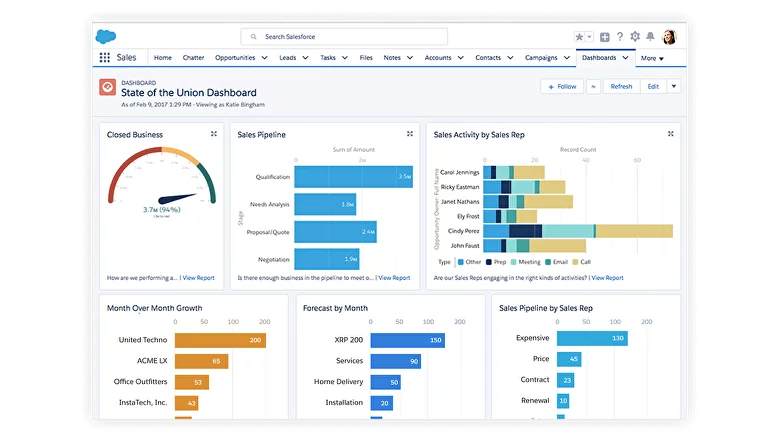
Leads by Source
How it works:
The report details the leads' origins. The current calendar year is a better choice for the report's time range. The data is presented in a pie chart on the dashboard. The report primarily assists in determining solutions for the sources of leads during the previous year and the proportion of each source of leads.
Why you need it:
With this report, you may better identify the source of your leads and adjust your marketing strategy and budget accordingly.
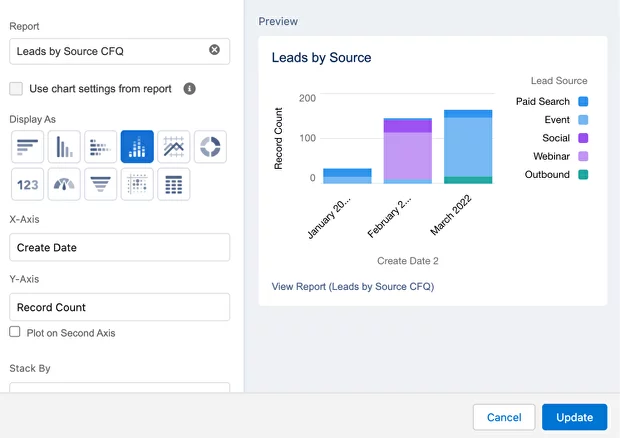
Conversion Rate
How it works:
A Conversions report shows visitors who have converted to prospects, along with their score, conversion point, and source referrer information.
Why you need it:
With this report, as in the case of the Sales Pipeline Report, you can optimize your marketing campaigns, understand what brings you income and what does not, develop effective channels. By understanding your conversion rates, you can optimize your sales strategies, allocate resources efficiently, and drive better business results.
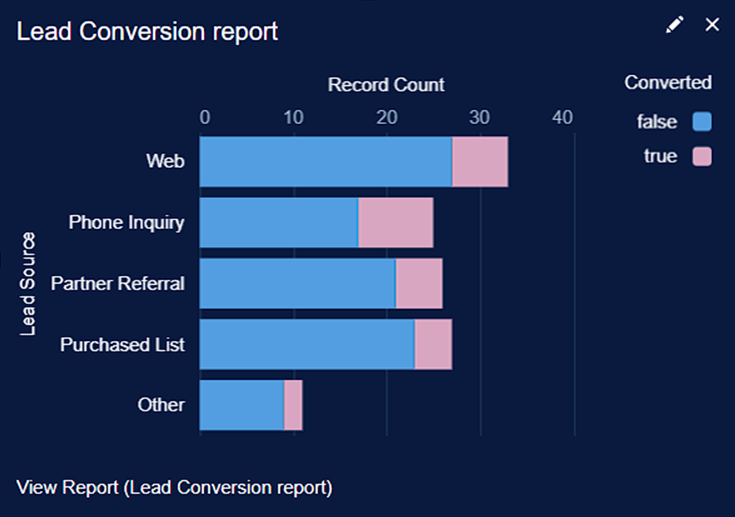
Campaign Influence
Campaign Influence is a feature that calculates the impact of campaigns on revenue share. It utilizes both standard and custom attribution models, which can be updated manually or automatically. By incorporating Customizable Campaign Influence data in related lists and reports, sales managers can gain visibility into the campaigns that are influencing their potential funnel.
The influence models analyze active campaigns to identify members who are also assigned a contact position in a new opportunity. Based on this relationship, the system generates a campaign influence record. However, once an opportunity stage is closed (either won or lost), no further influence records are generated.
You have the option to generate reports or dashboards for any active attribution model.
In Pardot, there are three Campaign Influence Attribution Models:
- First-Touch. This model assigns 100% of the impact and revenue to the first campaign that the prospect interacts with. Even if the prospect engages with other marketing assets or activities, the entire influence is attributed to the initial touchpoint.
- Even-Distribution. In this model, each campaign that a prospect interacts with receives an equal share of the effect and revenue. The influence is distributed evenly among all the campaigns the prospect engages with.
- Last-Touch. With the Last-Touch model, 100% of the effect and revenue is assigned to the prospect's last campaign before the contract is closed. This approach allocates all the influence to the final touchpoint, disregarding any previous campaigns the prospect may have interacted with.
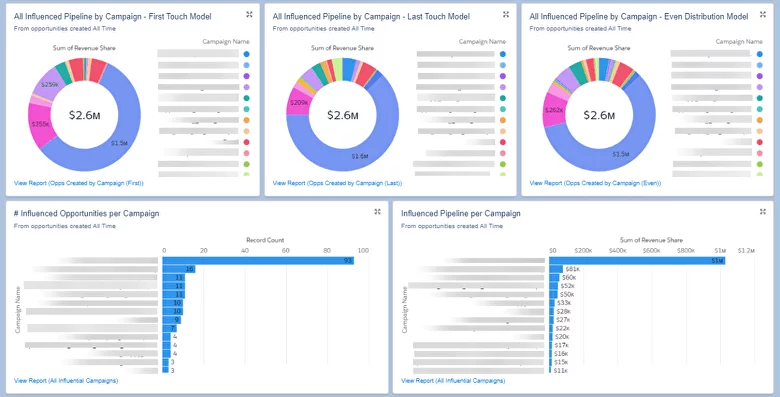
![]() Check out another amazing blog by Twistellar here: Native Accounting in Salesforce vs Accounting Software Integrations
Check out another amazing blog by Twistellar here: Native Accounting in Salesforce vs Accounting Software Integrations
To Wrap Up
Data is crucial in marketing, and measuring campaign performance is essential for making informed decisions and optimizing strategies. Marketing metrics can be used to track the effectiveness of actions. Salesforce offers a variety of marketing reports that provide valuable insights and help companies make data-driven decisions to optimize their marketing campaigns.
Contact us and we will help you set up your campaign hierarchy and strategy for getting the most out of your marketing efforts.




Responses